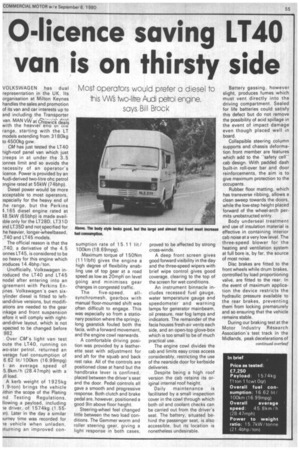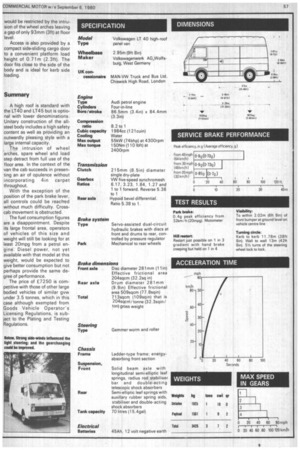0-licence saving LT40 van is on thirsty side
Page 57

Page 58

Page 59

If you've noticed an error in this article please click here to report it so we can fix it.
VOLKSWAGEN has dual representation in the UK. Its organisation at Milton Keynes handles the sales and promotion of its van and car interests up to and including the Transporter
van. MAN VVV a t Chi S-wgr. deals'
vvith the heavier emu oi we range, starting with the LT models extending from 3180kg to 4500kg gvw.
CM has just tested the LT40 high-roof panel van which just :.,-reeps in at under the 3.5 tonnes limit and so avoids the necessity of an operator's licence. Power is provided by an Audi-derived two-litre ohc petrol angine rated at 55kW (74bhp).
Diesel power would be more acceptable to most operators, specially for the heavy end of :he range, but the Perkins 1•165 diesel engine rated at $8.5kW (65bhp) is made avail)1ole only for the LT28D, LT31D rnd LT35D and not specified for he heavier, longerfwheelbased, _T40 and LT45 models.
The official reason is that the _T40, a derivative of the 4.5 onnes LT45, is considered to be oo heavy for this engine which iroduces 14.4bhp /ton, Unofficially, Volkswagen inroduced the LT40 and LT45 nodel after entering into an igreement with Perkins Enlines. Volkswagen's own sixylinder diesel is fitted to leftland-drive versions, but modifiations are needed to the gear Inkage and front suspension iefore it will comply with rightand-drive layout, which is not xpected to be changed before 982.
. Over CM's light van test oute the LT40, running on wo-star petrol, returned an verage fuel consumption of 6.62 lit/100km (16.99mpg) t an average speed of .5.8km /h (28.47mph) with a ill load.
A kerb weight of 1925kg 1.9-ton) brings the vehicle rithin the scope of the Plating rid Testing Regulations, llowing a payload, including le driver, of 1574kg (1.55 m). Later in the day a similar iurney time was recorded for le vehicle when unladen, ?turning an improved con sumption rate of 15.11 lit / 100km (18.69mpg).
Maximum torque of 150Nrn (1111Lift) gives the engine a high degree of flexibility enabling use of top gear at a road speed as low as 20mph on level going and minimises gear changes in congested traffic.
The five-speed, allsynchromesh, gearbox with manual floor-mounted shift was often difficult to engage. This was especially so from a stationary position where the springy, long gearstick fouled both the facia, with a forward movement, and the engine cowl rearwards.
A comfortable driving position was provided by a leatherette seat with adjustment for and aft for the squab and back rest rake. All of the controls are positioned close at hand but the handbrake lever is confined, placed between the driver's seat and the door. Pedal controls all gave a smooth and progressive response. Both clutch and brake pedal are, however, positioned a good 9in above floor height.
Steering-wheel feel changed little between the two load con ditions. The Gemmer worm and roller steering gear, giving a light response in both cases, proved to be affected by strong cross-winds.
A deep front screen gives good forward visibility in the day and the three-speed wipers with brief wipe control gives good coverage, clearing to the top of the screen for wet conditions.
An instrument binnacle includes recessed fuel gauge, water temperature gauge and speedometer and warning lamps for generator mainbeam, oil pressure, rear fog lamps and indicators. The remainder of the facia houses fresh-air vents each side, and an open-top glove-box which is too small to be of much practical use.
The engine cowl divides the cab and limits easy cross access considerably, restricting the use of the nearside door for kerbside deliveries.
Despite being a high roof version the cab retains its original internal roof height.
Daily maintenance is facilitated by a small inspection cover in the cowl through which both oil and coolant checks can be carried out from the driver's seat. The battery, situated behind the passenger seat, is also accessible, but its location is nonetheless undesirable. Battery gassing, however slight, produces fumes which must vent directly into the driving compartment. Sealed for life batteries could satisfy this defect but do not remove the possibility of acid spillage in the event of impact damage even though placed well in board.
Collapsible steering column supports and chassis deformation front member are features which add to the -safety cellcab design. With padded dash built-in roll-over bar and door reinforcements, the aim is to give maximum protection to the occupants.
Rubber floor matting, which has transverse ribbing, allows a clean sweep towards the doors, while the low-step height placed forward of the wheel-arch permits unobstructed entry.
Body uriderseal treatment and use of insulation material is effective in containing interior cab noise at a very low level. The three-speed blower for the heating and ventilation system at full bore is, by far, the source of most noise.
Disc brakes are fitted to the front wheels while drum brakes, controlled by load proportioning valve, are fitted to the rear. In the event of maximum application the device restricts the hydraulic pressure available to the rear brakes, preventing them from locking prematurely and so ensuring that the vehicle remains stable.
During our braking test at the Motor Industry Research Association's test track in the Midlands, peak decelerations of 0.9g were recorded combined with a short overall stopping distance without wheel lock-up or any hint of instability.
Over the ride and handling circuit the LT40 behaved quite passively and showed no positive signs of either oversteer or understeer. Small but sudden bumps amplified the stiffness of the suspension causing the payload to jump at the tail end.
Only with the long wheelbase 2.95m (9ft8in) LT models is the high-roof standard, Constructed from one-piece grp moulding, it doea not offer the loadbearing facility permitted with standard height steel roof van body.
The obvious advantage of a high roof is the extra internal capacity available which here totals 11 Scum (417cuft). A full head height of 1.87m (6ft1in) allows loading without, except for the Crery tall, crouching.
A platform area behind a cab high bulkhead measures 6.35sqrn (68.3sqft), but is not all available to the load. Rounded wheel arches intrude as does the stowage for the spare wheel and the side-step entry. However, the side panels are almost flat and vertical and most accommodating for stack. ing most types of commodity.
Extra capacity to the main area is provided by a mini Luton above the driving compartment which, poorly finished off on our test vehicle, was the only clear indication of the transition from the standard height van. Although standard on this model the Luton bears the signs of being a modification, once left to local bodybuilders to carry out, but now completed by the main manufacturing plant.
At the rear, full-height double doors open to restrained 90 degree or 1 80 degree. Although providing a rear entry measuring 1400mm x 1725mm (4ft7in x 5ft8in) movement forward of any full-width item would be restricted by the intrusion of the wheel arches leaving a gap of only 93mm (3ft) at floor level.
Access is also provided by a compact side-sliding cargo door to a convenient platform load height of 0.71m (2.3ft). The door fits close to the side of the body and is ideal for kerb side loading.
Summary
A high roof is standard with the LT40 and LT45 but is optional with lower denominations. Unitary construction of the all steel body includes a high safety content as well as providing an outwardly pleasing style with a large internal capacity.
The intrusion of wheel arches, spare wheel and load step detract from full use of the floor area. In the context of the van the cab succeeds in presen ting an air of opulence without incorporating 4in carpet throughout.
With the exception of the position of the park brake lever, all controls could be reached without much difficulty. Crosscab movement is obstructed.
The fuel consumption figures are a disappointment. Despite its large frontal area, operators of vehicles of this size and weight will still be looking for at least 20mpg from a petrol en gine. Diesel power, not yet available with that model at this weight, would be expected to give better consumption but not perhaps provide the same degree of performance.
The price of £7250 is cornpetitive with those of other large bodied vehicles of similar gvw under 3.5 tonnes, which in this case although exempted from Goods Vehicle Operator's Licensing Regulations, is subject to the Plating and Testing Regulations.




































































































































